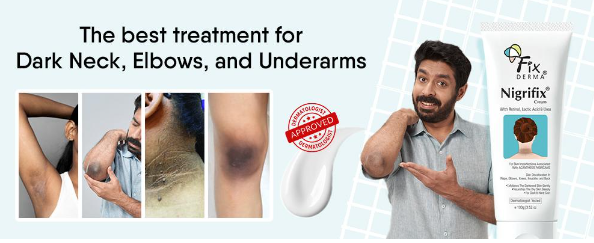Do you have a dark neck, knees, elbows, underarms, or nape? Is the skin becoming hard or velvety on these pigmented body areas? Then these skin issues could be due to an underlying cause known as Acanthosis Nigricans.
Acanthosis nigricans is a skin condition that causes dark, thick patches of skin to develop, primarily in the folds and creases of the body. These patches typically appear on the neck, armpits, groin, and other areas where skin rubs against skin.
Acanthosis nigricans is often associated with obesity and insulin resistance, which are both risk factors for type 2 diabetes. It can also be a side effect of certain medications or a sign of an underlying medical condition, such as polycystic ovary syndrome (PCOS) or cancer.
Keep reading to know about the symptoms and the underlying causes leading to Acanthosis Nigricans. Also, know why Fixderma’s Nigrifix Cream is the best dermatologist recommended treatment and our recommendation to reduce the pigmentation and darkness of the neck, elbows, underarms, and knees.
Symptoms:
The most common symptom of acanthosis nigricans is the appearance of dark, thickened patches of skin. These patches may be smooth and velvety or have a rough, bumpy texture. They typically occur in areas of the body where the skin folds or creases, such as the neck, armpits, groin, and elbows. In some cases, the skin may also be itchy or have a foul odour.
Causes:
The exact cause of acanthosis nigricans is not fully understood, but it is thought to be related to insulin resistance, which is a hallmark of type 2 diabetes. When the body becomes resistant to insulin, it produces more of the hormone to try to compensate. This excess insulin can stimulate the growth of skin cells, leading to the formation of thick, dark patches.
Other factors that may contribute to the development of acanthosis nigricans include:
- Obesity: People who are overweight or obese are more likely to develop acanthosis nigricans.
- Medications: Certain medications, such as oral contraceptives and steroids, can cause acanthosis nigricans as a side effect.
- Medical conditions: Acanthosis nigricans may be a sign of an underlying medical condition, such as PCOS or cancer.
Treatment:
Proper and consistent treatment can help improve the appearance of the skin and reduce symptoms. The primary treatment for acanthosis nigricans is to address any underlying medical conditions, such as diabetes or PCOS.
In addition to treating the underlying condition, other treatments for acanthosis nigricans may include:
- Topical creams: Prescription creams, such as retinoids and alpha hydroxy acids, can help improve the texture and appearance of the skin.
- Laser therapy: Laser therapy can be used to remove the top layer of skin, which can help reduce the appearance of the patches.
- Weight loss: Losing weight can help improve insulin resistance and reduce the severity of acanthosis nigricans.
OUR RECOMMENDATION: Fixderma Nigrifix Cream (Topical Treatment)
Nigrifix cream is an innovative product, that is specially formulated to reduce the darkness and skin hardness caused due to Acanthosis Nigricans on the body folds and creases such as on the neck, elbows, knuckles, underarms, and nape.
The special composition of Nigrifix cream helps to get rid of those difficult-to-remove dark spots. Unlike other harsh exfoliators, Nigrifix softly exfoliates and leaves the skin incredibly moisturized. The cream has a light, non-greasy texture that absorbs quickly and deeply into the epidermis.
This cream is formulated with 10% Lactic Acid, which gently exfoliates dark, hard, and velvety, and 8% Urea, which treats dry and rough skin conditions on these body folds. Nigrifix cream is trusted and recommended by dermatologists and proven to be India’s no. 1 formulation to reduce pigmentation related to Acanthosis Nigricans.
How to use Nigrifix Cream?
Any skin type can use it twice daily for two months on body areas like the neck, nape, thighs, elbows, knees, knuckles, and back. Keep in mind to follow it religiously—consistency is essential!
- The product needs to be used at least 𝟑 𝐦𝐨𝐧𝐭𝐡𝐬 𝐭𝐰𝐢𝐜𝐞 𝐚 𝐝𝐚𝐲 𝐟𝐨𝐫 𝐯𝐢𝐬𝐢𝐛𝐥𝐞 𝐫𝐞𝐬𝐮𝐥𝐭𝐬.
- 𝐃𝐨 𝐧𝐨𝐭 𝐟𝐨𝐫𝐠𝐞𝐭 𝐭𝐨 𝐚𝐩𝐩𝐥𝐲 𝐬𝐮𝐧𝐬𝐜𝐫𝐞𝐞𝐧 in the daytime if the area is exposed to the sun.
- Results may vary depending on the severity of the case. 𝐒𝐭𝐮𝐛𝐛𝐨𝐫𝐧 𝐩𝐢𝐠𝐦𝐞𝐧𝐭𝐚𝐭𝐢𝐨𝐧 𝐦𝐚𝐲 𝐭𝐚𝐤𝐞 𝐦𝐨𝐫𝐞 𝐭𝐢𝐦𝐞 𝐭𝐨 𝐯𝐚𝐧𝐢𝐬𝐡 𝐭𝐡𝐚𝐧 𝐥𝐢𝐠𝐡𝐭𝐞𝐫 𝐩𝐢𝐠𝐦𝐞𝐧𝐭𝐚𝐭𝐢𝐨𝐧.
P.S: THIS IS NOT A FACE CREAM
Do a patch test first before using including any product in your skincare regime.
Prevention:
The best way to prevent acanthosis nigricans from within is to maintain a healthy weight and avoid or manage conditions that can contribute to insulin resistance, such as type 2 diabetes and PCOS. Eating a healthy diet and getting regular exercise can also help improve insulin sensitivity and reduce the risk of acanthosis nigricans.
In conclusion, acanthosis nigricans is a skin condition that can be caused by a variety of factors, including insulin resistance, obesity, and certain medical conditions. The treatment can help improve the appearance of the skin and reduce symptoms. Maintaining a healthy weight and managing any underlying medical conditions can help prevent the development of acanthosis nigricans


